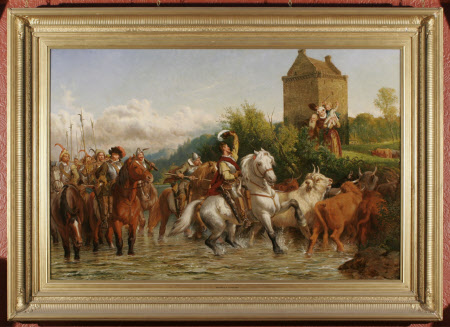Gilnockie Tower in 1530, Dumfriesshire
Henry Hetherington Emmerson (Chester-le-Street 1831 – Cullercoats 1895)
Category
Art / Oil paintings
Date
1880 (signed and dated)
Materials
Oil on canvas
Measurements
1180 x 1790 mm
Place of origin
Northumberland
Order this imageCollection
Cragside, Northumberland
NT 1230254
Caption
Lord Armstrong claimed to be related to Johnnie Armstrong of Gilnockie, a notorious 16th-century border reiver (or bandit), whose exploits were immortalised in Sir Walter Scott’s ballad of ‘Johnie Armstrang’. Johnnie was executed with other members of his ‘gallant companie’ on the orders of James V at Hawick in 1530. Emmerson's painting shows the triumphant reivers returning to Gilnockie Tower in Dumfrieshire after a raid. The Gilnockie Tower at Cragside was designed by Richard Norman Shaw in the early 1870s in imitation of the original building.
Summary
Oil painting on canvas, Gilnockie Tower in 1530, Dumfrieshire by Henry Hetherington Emmerson (Chester-le-Street 1831 – Cullercoats 1895), signed and dated, bottom left: H H Emmerson 1880. A painting of Gilnockie Tower, Dumfrieshire, with a party of border raiders on horseback, returning with a drove of cattle being driven through water in the foreground. Johnnie Armstrong of Gilnockie Tower and his retinue of freebooters are returning to Gilnockie with a drove of cattle after a successful Border raid. He and forty-eight of his followers were hanged near Hawick in the same year on the orders of James V of Scotland. The design of Gilnockie Tower at Cragside (Norman Shaw's tower which terminates the south front) was based on the 1530 Tower, still standing there at the time.
Provenance
Presumably acquired by Sir William George Armstrong, 1st Baron Armstrong of Cragside (1810-1900); thence by descent; transferred by the Treasury to The National Trust in 1977 via the National Land Fund, aided by 3rd Baron Armstrong of Bamburgh and Cragside (1919 - 1987).
Credit line
Cragside, The Armstrong Collection (acquired through the National Land Fund and transferred to the National Trust in 1977)
Marks and inscriptions
Bottom left: H. H. Emmerson 1880
Makers and roles
Henry Hetherington Emmerson (Chester-le-Street 1831 – Cullercoats 1895), artist

